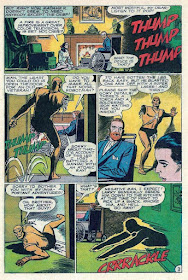Carl Burgos was born Max Finkelstein on April 18, 1916, in New York, New York. The birth date is based on the Social Security Death Index and his parents’ petitions for naturalization at Ancestry.com.
Burgos’s father was Isidor Finkelstein, a tailor, whose naturalization petition, dated December 13, 1923, said he was born in Moghielev, Russia, on October 25, 1886. (Isidor’s World War II draft card said his birth was October 15, 1886 in Zlobin, Russia.) He sailed on the steamship Merion which departed Antwerp, Belgium, on November 16, 1907. The ship arrived in New York City on November 29, 1907. Isidor became a naturalized citizen February 14, 1927.
Burgos’s mother was Ester Bielin, a dressmaker, whose naturalization petition said she was born in Stressin, Russia, on March 2, 1886. She sailed on the steamship Samland which departed from Antwerp, Belgium. The ship arrived in New York City on April 2, 1907. She married Isidor on August 26, 1911. On the petition, dated June 27, 1941, her first name was spelled Esther. She became a naturalized citizen July 16, 1942.
Burgos’s brother, Rubin Finkelstein, was born March 2, 1912, in New York City. Rubin married Clara Cantor on March 30, 1935 in Manhattan, according to the New York, New York, Marriage Index at Ancestry.com. Clara passed away May 22, 1996. Rubin passed away May 20, 2003.
The 1920 U.S. Federal Census recorded the Finkelsteins in Manhattan, New York City at 191 East 100 Street.
The same address was in the 1925 New York state census.
In the 1930 census, the Finkelstein family resided in the Bronx at 945 Faile Street.
In the Steranko History of Comics (1970), page 58, Steranko wrote:
The man responsible for the inflammable fury [The Human Torch] was Carl Burgos. Born in New York in 1917 [sic], his childhood was little different than most others except for his natural artistic talent and unruly imagination. In his early teens he enrolled in the National Academy of Design. “I quit after one year because I couldn’t learn enough,” Burgos says.An overview of Burgos’s comics career is at Who’s Who of American Comic Books 1928–1999. Many of his comic book credits are at the Grand Comics Database. A collection of images from Google is here.
At 17, he took a job with the Franklin Engraving Company which just happened to be the firm that engraved the plates for a line of comic books produced by Harry A. Chesler. For the first time, Burgos was exposed to stacks of original comic art. Whenever possible, he took the time to study the artist’s techniques, their pen styles and brush strokes. He discovered he could draw as well as some and better than a few who already worked in comics. He formulated an idea about becoming a comic artist. What could he lose?
According to the 1940 census, Burgos and his parents lived at 602 West 157th Street in Manhattan. Burgos’s occupation was artist in the newspaper industry. He had completed four years of high school.
A 1942 Manhattan city directory had this listing: “Burgos Carl 602W157…..AU dubn 3-4117”.
During World War II, Burgos enlisted as Max Finkelstein. In the Steranko History of Comics, Burgos said “I started in the Air Force, took infantry ranger training, went overseas as a rifleman, was transferred to the Signal Corps, and came back in the engineers. It sounds crazy, but it could only happen to a comic book man.” The Department of Veterans Affairs Beneficiary Identification Records Locator Subsystem (BIRLS) Death File, at Ancestry. com, said he was discharged March 18, 1946.
Alter Ego #49, June 2005, published “The Privacy Act of Carl Burgos”, Jim Amash’s interview with Burgos’s daughter Susan, a teacher and animation artist. She mentioned her mother, Doris, sister, Linda, grandparents and uncle. Doris’s Social Security application, at Ancestry.com, had her full maiden name. In July 1947 her name was Doris Finkelstein, then in September 1948 she was Doris Burgos.
In 1968 Burgos filed copyright renewals on his creation, the Human Torch. The renewal registrations were published in the Catalog of Copyright Entries, Third Series, Volume 22, Part 1, Number 1, Section 1, Books and Pamphlets, Current and Renewal Registrations, January–June 1968, on page 1256
and in the Catalog of Copyright Entries, Third Series, Volume 22, Part 1, Number 2, Section 1, Books and Pamphlets, Current and Renewal Registrations, July–December 1968, on pages 2761 and 2762.
Burgos’s copyright renewal filings were mentioned in the article “The true story of life at Marvel Comics in the glory days of Jack Kirby and Stan Lee”.
Burgos passed away March 5, 1984, according to the Department of Veterans Affairs BIRLS file. American Comic Book Chronicles: The 1980s (2013) said Burgos died on March 7. The Social Security Death Index said Burgos’s last residence was Franklin Square, New York. His wife, Doris, passed away January 2, 2002.
Further Reading
Timely-Atlas-Comics: Happy 100th Birthday To Carl Burgos
Comics Alliance
The Weird World of Eerie Publications: Comic Gore That Warped Millions of Young Minds
The Beat: When Carl Burgos tried to sue for the Human Torch
Tales to Astonish: Jack Kirby, Stan Lee, and the American Comic Book Revolution
Sub-Mariner & The Original Human Torch, Volume 1
Alter Ego #108, April 2012: “With the Fathers of Our Heroes”
Find a Grave
Lambiek Comiclopedia
Wikipedia
















